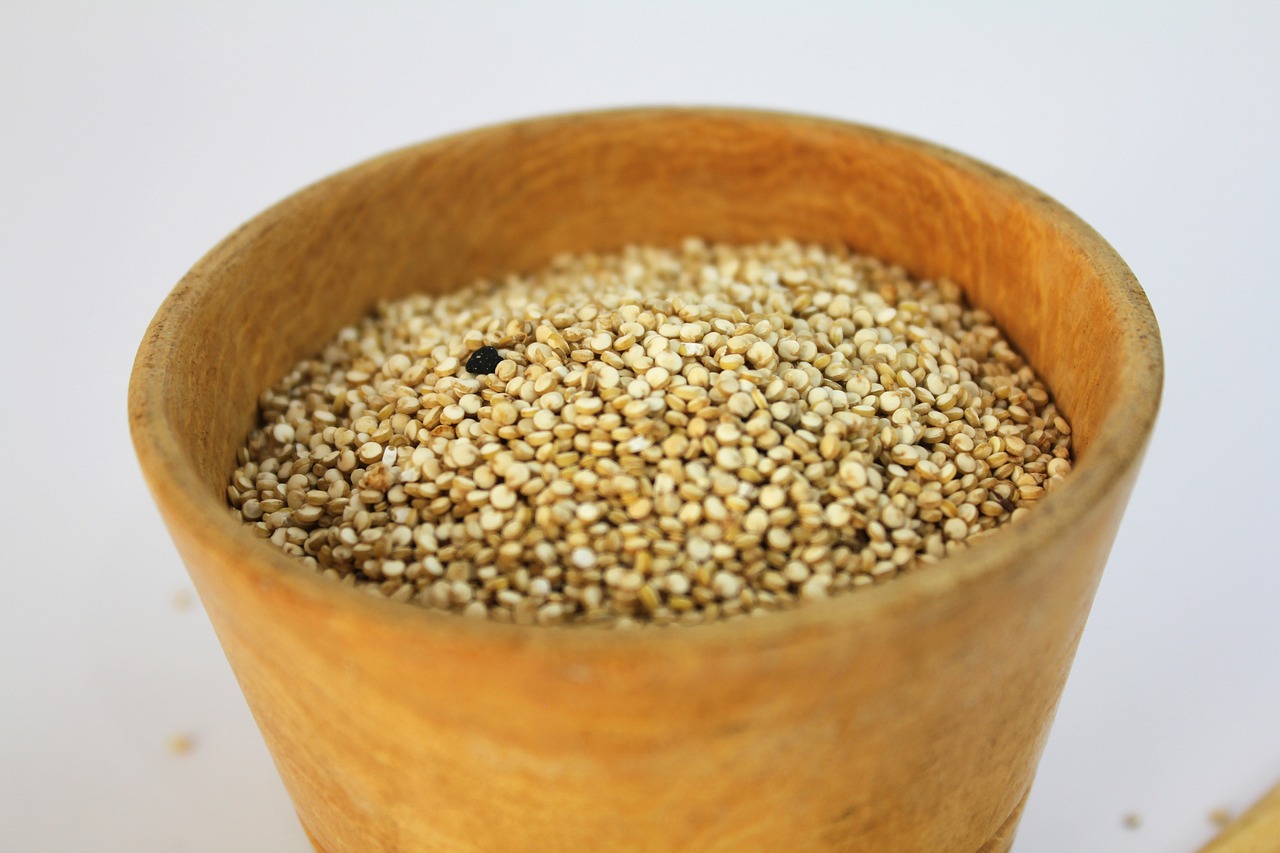Although amaranth is regarded by many as an unwanted plant, at least fifty tropical countries around the world grow it as a vegetable, and not only in their backyards. In the humid lowlands of Africa and Asia, it is probably the most widely eaten boiled greens.
During the production season, the leaves provide African communities with at least a quarter of their daily protein. In parts of West Africa, the young seedlings are pulled up by the roots and sold in town markets. Other parts of Africa also rely on them and in Southern Africa, it is well-known and widely used. Many of the more than fifty Amaranthus species in both tropical and temperate regions are eaten, but only a dozen or so can be considered domesticated.
What is amaranth?
The Amaranthus species belong to the family Amaranthaceae. Common names in Afrikaans are hanekam, misbredie or varkbossie, in English pigweed, bush greens, or green leaf. In Congo, the Amaranthus viridis in Kinshasa Province is known as bitekuteku, in Ghana as madze, in Sierre Leone as grins, in Nigeria as efo and in Malawi as bonongwe.
Amaranthus species are herbaceous, short-lived annuals. The dwarf forms grow about 60 cm tall, but some variants grow up to 2 m. The stems are mostly upright, thick, fleshy, sometimes grooved, and sparsely branched with alternate leaves. The leaves differ in shape, and are mostly green, red, or purplish in colour. The flowers or inflorescence are red to purple and borne on spikes. The seeds are small, shiny and either black, brown, or white. Species with white seeds are used as a cereal, while the species with darker seed are used as leafy vegetables.
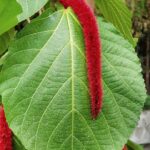
Amaranths are grown for their leaves, which are boiled like spinach. (Source: Pixabay)
Distribution
Amaranthus cruentus (A. hybridus), A. blitum and A. dubius are the most widely grown in Africa and are particularly important in West Africa. One of the least known and least developed species is Amaranthus thunberghii, a semi-wild species native to Southern Africa, that grows very fast and is resistant to water stress.
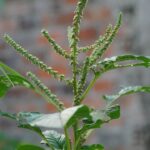
Young leaves, stems and flowers are used in stews and soups. (Source: Pixabay)
History
Amaranthus cruentus has a long stem and bears a large deep-red inflorescence with dark seeds, and is also used as an ornamental plant. This plant, like maize, sweet potatoes, and peanuts, was evidently brought from America to Africa by Europeans. It has probably been used as a vegetable since the 16th or 17th centuries.
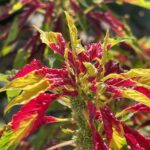
Multicoloured leaves on an amaranth plant. The colour leaches out when the leaves are boiled, and the water should be thrown away. (Source: Pixabay)
Eating amaranths
Vegetable amaranths are probably the most widely eaten boiled greens throughout Africa’s humid lowlands. The leaves and stems make excellent boiled vegetables with a soft texture, mild flavour, and no trace of bitterness.

Seeds used as a cereal can be white, brown, or black. (Source: Pixabay)
Food value
The nutritional quality of amaranth greens is equal to leafy vegetables like spinach, but with more minerals like iron and calcium. Protein levels in the leaves are reported to be around 25%, which makes them useful supplements to cereals and root foods. Vegetable amaranths are important sources of vitamin C as well as abundant precursors for producing vitamin A, which is necessary for good eyesight.
Heating or treating the Amaranthus thunberghii extract with acid triggers the nutrients as a leaf-protein concentrate. Its leaf protein is highly extractable, and in the process, most other nutrients are extracted as well, including provitamin A, polyunsaturated lipids (linoleic acid), and iron. The resulting leaf-nutrient concentrate is especially useful for young children and other persons with particularly high protein, vitamin A, and iron needs.
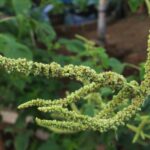
Uses
Amaranth is a multiple-duty crop. Leaves, young stems, and young inflorescences are eaten as potherbs. The plant material softens up quickly and thus requires only a few minutes of cooking. The leaf is used in soups and stews. Rubbed through a sieve, the leaves can be served as a puree. The fresh young leaves and leaf stems can be used raw in a salad.
It is also popular as a microgreen in high-end restaurants.
The mature flowers are not edible but utilised for their seeds. Several species, including Amaranthus cruentus, A. hypochondriacus, and A. caudatus are grown for their grain-like seeds. These seeds have the same carbohydrate content as wheat but have more protein and oil. In many areas, seeds are dried out and milled into flour for making gluten-free bread and pancakes. The flowers are good for honey production.
The vegetable amaranth can also be used in feedlots for cattle or other intensively reared animals, including pigs.
It has been reported that women in Queenstown in the Eastern Cape, South Africa eat the greens, believing that the young tops promote the flow of a breastfeeding mother.
Caution
When boiling red leaves, the pigment that is released in the water must be discarded as these can contain anti-nutritional factors which prevents the ability to utilise nutrients. Young and very tender leaves have the least amounts of these undesirable materials, which is why the plants should well-watered and fertilised, and picked early and often.
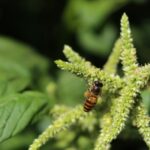
The flowers are good for honey production. (Source: Pixabay)
Growing amaranths
Amaranths are a pioneer species which quickly colonises disturbed land. They produce plenty of seeds, which germinate rapidly, and the seedlings soon appear, so the first crop of leaves is sometimes harvested within three weeks of planting. New leaves keep appearing and up to 10 tonnes of edible greens per hectare in a period of 30 to 40 days have been recorded.
Amaranths grown as vegetables need a long, warm growing season in hotter climates. The crop thrives in areas with high rainfall. Where it is grown in small garden plots, it is often watered by hand. Without irrigation, it needs at least 8 mm of rainfall per day throughout the season.
Humid lowlands below 800 m are said to be most suitable for cultivation, but the crop can be grown in higher areas.
All species are very sensitive to cold weather and the plant stops growing at about 8 °C. Most species are tolerant of high temperatures and thrive within a temperature range of 22 °C to 40 °C.
Although most amaranths tolerate different soils, they thrive in light, sandy, well-drained, and fertile loam with a high organic content and adequate nutrient reserves. The optimum pH range is 5,5 to 7,5, but some cultivars tolerate more alkaline conditions.
To increase leaf growth, the growing tip is pinched out to force branching with new leaf growth and suppressing early flowering. Watering, and fertilisation with manure, compost, or nitrogen fertiliser during the growing season, stimulate leafy growth and boost yield, generating the greatest quantity of the tenderest leaves. The plant can grow in shade near other plants, including bananas, cassava, and trees. Amaranth greens are mostly grown, harvested, and marketed close to home, and women are the prime producers. The surplus is sold at village markets.
In warm climates it can be grown all year round and because of its short lifecycle of about eight weeks, it is suitable for multiple cropping. Amaranth is also highly suitable for incorporation into crop rotations as it is usually unaffected by common soil diseases such as nematodes, fungal, and bacterial wilt.
Limitations
The small grains are tricky to sow, but mixing them with sand and sowing the combination, ensure that they are uniformly distributed. Hard rain can wash the seeds away, but covering with a thin layer of grass mulch, which is removed after germination, can solve the problem.
The seeds can also be sown in seed trays and the seedlings planted out when the conditions are favourable.
Pests and diseases
Slugs and snails, as well as leaf-eating insects like grasshoppers and beetles, can damage the leaves. Covering the crop with netting is one solution, but it is not widely used.
The plants are susceptible to viruses as well as fungal diseases, especially when they are young and when the weather is damp. If the seedbeds are well drained and located in sunny sites, it will eliminate some problems.
References
National Academies of Sciences, Engineering, and Medicine. 2006. Lost Crops of Africa: Volume II: Vegetables. Washington, DC: The National Academies Press. https://doi.org/10.17226/11763. https://nap.nationalacademies.org/read/11763/chapter/3#51

